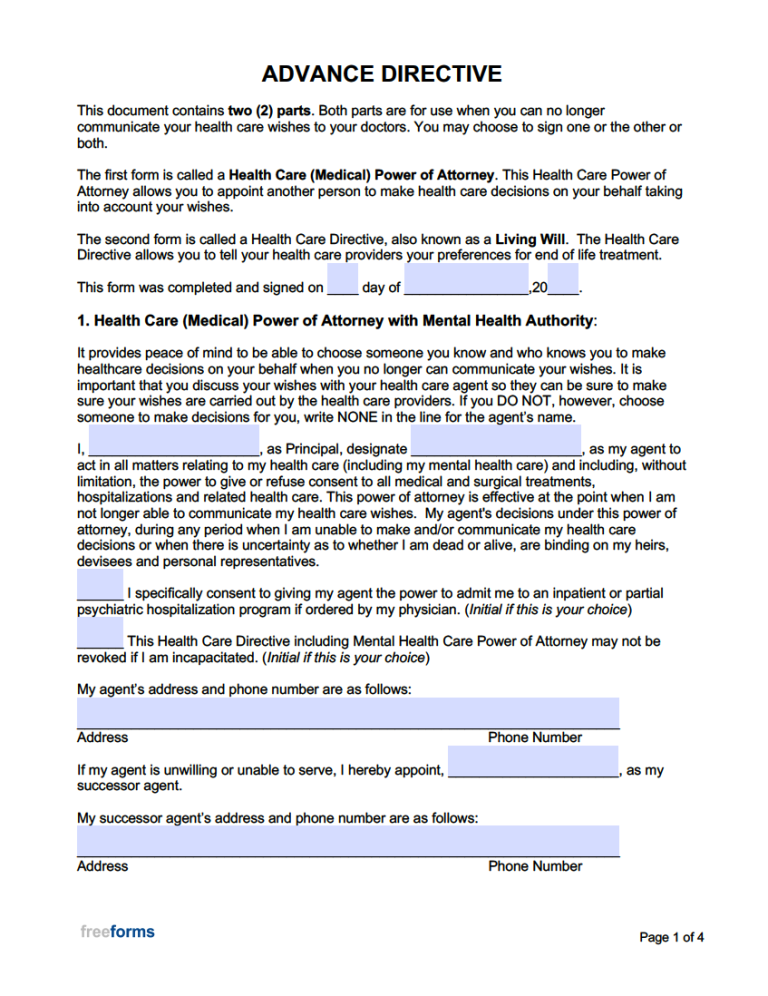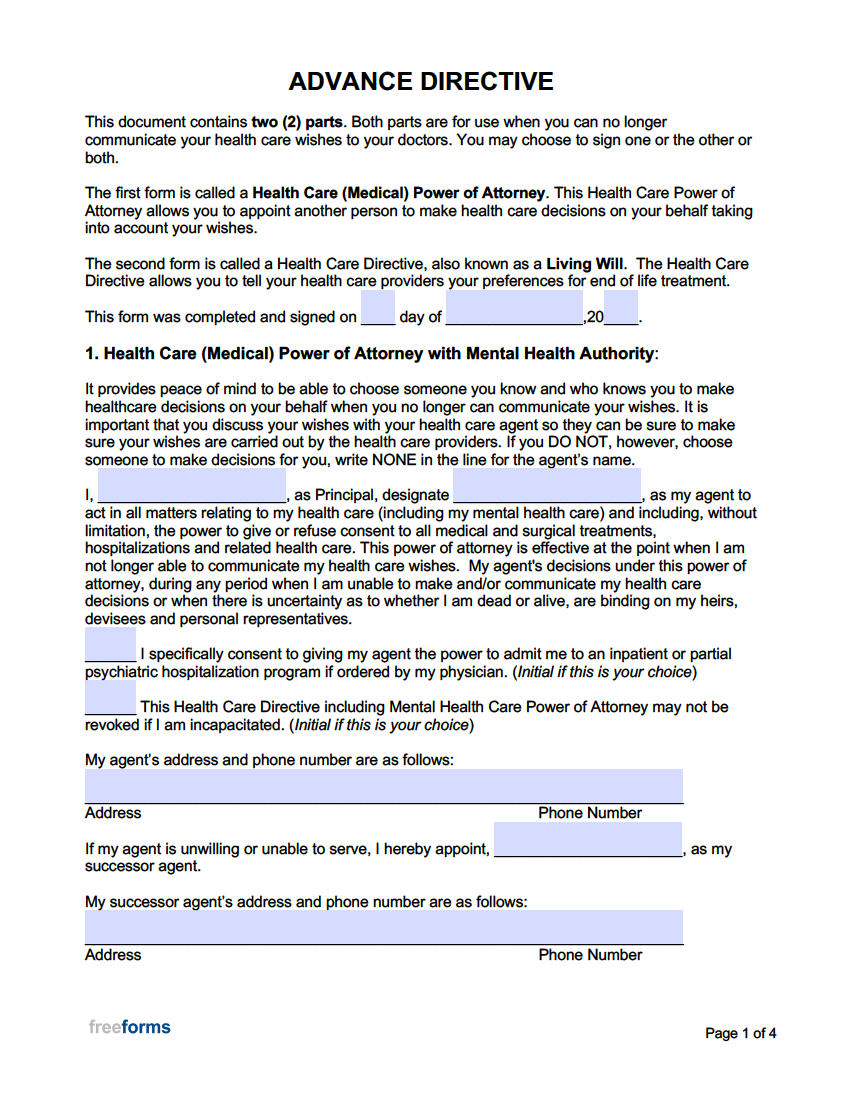This Document Contains:
By State
- Alabama
- Alaska
- Arizona
- Arkansas
- California
- Colorado
- Connecticut
- Delaware
- Florida
- Georgia
- Hawaii
- Idaho
- Illinois
- Indiana
- Iowa
- Kansas
- Kentucky
- Louisiana
- Maine
- Maryland
- Massachusetts
- Michigan
- Minnesota
- Mississippi
- Missouri
- Montana
- Nebraska
- Nevada
- New Hampshire
- New Jersey
- New Mexico
- New York
- North Carolina
- North Dakota
- Ohio
- Oklahoma
- Oregon
- Pennsylvania
- Rhode Island
- South Carolina
- South Dakota
- Tennessee
- Texas
- Utah
- Vermont
- Virginia
- Washington
- West Virginia
- Wisconsin
- Wyoming
What Is an Advance Directive?
An advance directive is a medical form that contains an individual’s preferences regarding health care procedures at the time of their incapacity. It must be created in advance while the individual has the mental capability of making sound decisions. It serves two (2) main purposes:
- Declaring Your Wishes – Users of the instrument can record their desired course of action pertaining to end-of-life care should they ever enter a comatose state.
- Appointing an Agent – In addition to the declaration, the principal can assign an attorney-in-fact to manage other aspects of their health care treatment when they are unable to do so for themselves.
How to Make an Advance Directive
Whether you’re young or old, sick or healthy, it is never a bad idea to complete an advance directive to let your wishes be known regarding medical treatment at the time of incapacitation. Individuals can proactively combat some of the burdens their loved ones might have to endure should they ever face serious health complications.
Anyone interested in executing this document must be at least eighteen (18) years of age or older. In this guide, we are going to go over how to create a legally binding advance directive in six (6) simple steps.
- Step 1 – Choose an Agent
- Step 2 – Determine End-of-Life Preferences
- Step 3 – Obtain an Advance Directive Form
- Step 4 – Fill Out the Document
- Step 5 – Signatures and Acknowledgment
- Step 6 – File Your Advance Directive
Step 1 – Choose an Agent
Customarily, the first decision the principal will have to make in regard to carrying out an advance directive is determining who their agent will be. This portion of the form is what’s called a “medical power of attorney”, and it provides individuals with the ability to assign a third-party representative to handle certain health care decisions on their behalf. So it is important that the granting party select someone that they feel has their best interest at heart, e.g., a family member, close friend, or another person of trust.
Step 2 – Determine End-of-Life Preferences
Before carrying out an advance directive, you should think about what you want to occur in an emergency situation involving your incapacitation due to health complications. The section of the form dedicated to relaying these preferences is what’s known as a “living will”, which allows the executor to establish their own guidelines surrounding resuscitation efforts, life-sustaining treatments, pain management, and any other end-of-life issues. Individuals seeking to accomplish an advance directive should reflect on what they deem acceptable and unacceptable in terms of quality of life.
Step 3 – Obtain an Advance Directive Form
After getting a general idea of your criteria, you should make sure that you acquire a form that corresponds with your local laws. Visit the state-by-state section above to select a document that complies with your region’s rules and regulations.
Step 4 – Fill Out the Document
Once you have found a form that meets your standards, you will need to fill in the blanks with the requested information and make any necessary selections. Users may either fill out the instrument by hand or digitally. Some of the details that may be required within the document include:
- Names and addresses of the principal and agent.
- Limitations surrounding the principal-agent relationship (if any).
- Instructions concerning medical care at the point of incapacitation.
- Description of any end-of-life wishes the principal may have.
Step 5 – Signatures and Acknowledgment
Following the recording of all the pertinent information, the executing party must then sign the instrument to validate the form. Prior to supplying their endorsement, the principal should research what stipulations their state imposes for signing. Most states will require that the individual sign in the presence of witnesses and/or a notary public.
Step 6 – File the Advance Directive
Now that you have completed your advance directive, you may wonder what to do with the document. Certain states across the country maintain a local database where residents can upload their forms. This allows various health care facilities within the community to easily look up whether or not a patient has an advance directive in place. With that being said, many states still have not adopted this system and it is up to the principal to distribute copies to their family and physician to make sure that their directions are known. (It is also recommended that you preserve your own copy to have on record.)
Frequently Asked Questions (FAQ)
What Are the Three (3) Types of Advance Directives?
There are three (3) types of documents individuals should consider executing when planning for the future:
- Medical Power of Attorney – Grants another individual of the patient’s choice the ability to act in their place regarding health care decisions when they cannot function for themselves.
- Living Will – Allows the patient to record their priorities in terms of what medical procedures they want or do not want to be administered at the time of incapacitation.
- Durable (Financial) Power of Attorney – Although it is not generally referred to as an advance directive, this is a supplementary document that can provide an attorney-in-fact with the authority to conduct certain financial affairs for the principal should they become disabled, e.g., banking, paying bills, managing property, etc.
Is an Advance Directive the Same as a Living Will?
Although certain areas of the country may use these terms interchangeably, there is a general distinction between the two documents. A living will usually only allows the principal to state their own wishes regarding medical treatment at the time of incapacitation. An advance directive contains a living will section in addition to a medical power of attorney that can enable an agent to make health care decisions for the principal when they are unable to do so themselves.
What Is the Difference Between an Advance Directive and Medical Power of Attorney?
A medical power of attorney is a document that assigns an agent the right to handle health care matters for another person (typically when the individual is incapacitated). An advance directive contains this feature plus a living will portion that can be utilized by the principal to declare their own priorities regarding end-of-life care.
Can Family Override an Advance Directive?
When an advance directive has been filled out, signed, and acknowledged properly, it becomes an official document that establishes a person’s desires regarding end-of-life care. It can also grant a health care proxy the ability to act for the principal under certain dire health care situations. Sometimes, the family of the document’s executor may disagree with the choices made by their loved one and insist that they be altered. This is not allowed and the medical staff must refer to the preferences recorded within the advance directive rather than the family’s pleading. With that said, if the family claims that the agent assigned within the document is unfit to serve the role, they may be able to revoke the authority by appearing before a local court with sufficient evidence confirming their accusations.
Do Advance Directives Need to Be Notarized?
The answer to this question depends on the state in which the document is being executed. Some states will require signing to occur in the presence of a notary public, whereas others only necessitate the acknowledgment of witnesses.
Is a DNR an Advance Directive?
Certain areas within the country offer what is known as a “do-not-resuscitate” (DNR) order. As you may be able to gather from the title, this is a document that specifically focuses on one’s wishes not to be resuscitated through CPR at the time of respiratory or cardiac arrest. Although this can be stipulated within an advance directive, a DNR order is more official, requiring the endorsement of a physician. Individuals who would like to execute this document are usually also provided with the option of ordering special bracelets (or necklaces) that can be worn to inform paramedics of their wishes should they receive an emergency response. (Interested parties may attach this to their advance directive if desired.)
What Should Be Included in an Advance Directive?
Executors of this instrument should include the following details within the content of the form:
- Date of Execution
- Information identifying the principal and agent.
- Preferences in relation to life support, life-sustaining treatments, and any other end-of-life wishes.
- Their signature along with the acknowledgment of witnesses and/or notary public.
Do Advance Directives Expire?
No, an advance directive does not expire at any point unless the principal decides to revoke it. That being said, it is important that you preserve the original for your records and provide doctors, family members, and any other relevant individuals with a copy of the completed form so that it can be referred to in the future.
What Is a Psychiatric Advance Directive?
As a standard advance directive is geared towards end-of-life medical decisions, the psychiatric version is designated for those who may become unfit to function for themselves due to mental health issues. Not all states have adopted this form, so individuals interested in carrying out such a document should research their local legislature.
Do You Need a Lawyer for Advance Directives?
No, completing an advance directive is a fairly simple task that requires basic details concerning the parties involved and the medical preferences of its executor. Once the data has been entered, the principal must sign the document and receive the acknowledgment of witnessing individuals and/or a notarial officer.
What Is the Difference Between an Advance Directive and POLST?
POLST is a national program dedicated to fulfilling the health care wishes of the seriously ill/frail population. It generally stands for “Physician Orders for Life-Sustaining Treatment”, although each state may have its own acronym for the document, e.g., POST, MOST, MOLST, etc. Even though you can declare the same end-of-life wishes in an advance directive that you can in a POLST, a POLST document is more authoritative as it must be accompanied by the signature of an attending physician.
When Do Advance Directives Take Effect?
The moment the principal has been determined incapacitated by a health care professional.
Do I Need an Advance Directive?
Nobody is required to have an advance directive, it is simply a measure taken to express your desires regarding medical treatment should you not be able to communicate them in the future due to a health care crisis.
Sample Advance Directive Form
Download: Adobe PDF, MS Word (.docx)


